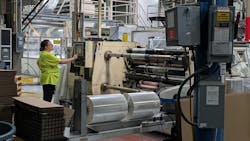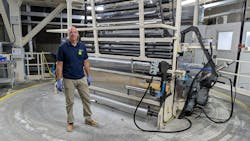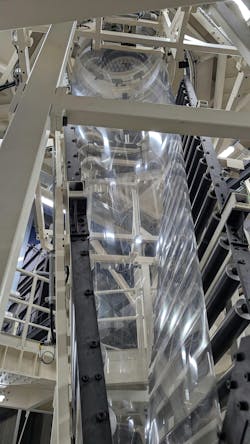Intertape Polymer Group (IPG) Tremonton, Utah: A Best Plants Three-Peat
Key Highlights
- Intertape Polymer Group's Tremonton plant has achieved its third consecutive IndustryWeek Best Plants Award.
- Digital transformation and internet-connected machinery have played a crucial role in reducing scrap and enhancing process reliability in fragile, high-quality shrink film production.
- Enhanced daily communication, including tier boards and daily reports, has improved teamwork and problem-solving, especially post-COVID when face-to-face interactions declined.
- The plant’s success demonstrates that balancing technological tools with human-centric approaches is essential for sustaining operational excellence in a competitive environment.
Continuous improvement practices create many rewards, but there’s an inherent punishment. Every success creates a new floor for future performance. Every win makes the next one more difficult. So, when editors and outside judges consider a plant for a third consecutive IndustryWeek Best Plants Awards win, the bar gets pretty darned high.
At Intertape Polymer Group IPG)’s Tremonton, Utah, facility, Plant Operations Manager Bill Bourgeous says managers and employees faced significant challenges after their 2021 win. Demand was up sharply, but COVID-19-era restrictions made daily face-to-face interactions difficult, and a few key metrics slipped.
“It feels like climbing rope. All of us that have been through operational excellence journeys, you’re climbing rope. It’s not easy. It’s hand over hand. You pull,” Bourgeous says. “But if you let go, you ease up at all, you fall really fast.”
The Tremonton plant, about an hour north of Salt Lake City, overcame its challenges, resumed that upward climb and racked up its third consecutive win for several big reasons:
- Past successes lead to higher ambitions: Tremonton is producing harder-to-make, higher-profit-margin products than it was a few years ago because it proved it could do the hard things.
- Improvements in most critical performance indicators: Scrap is down, as are customer rejects, despite the plant making more finicky, fragile materials.
- People-centric approaches: Managers point to better daily communications, employee process improvement suggestions and greater engagement with the workforce for the majority of its recent successes.
Success Leads to New Challenges
Pessimists often say that the reward for hard work is more work, and that could be true for IPG Tremonton. Because the company excelled at stretch wrap and shrink film, corporate leadership tasked the plant with more shrink film and a new product – shrink film made from post-consumer recycled plastics.
IPG, Tremonton
- Tremonton, Utah
- Employees: 93
- Total Square Footage: 115,540
- Primary Product: Shrink film for consumer packaged goods and other applications
- Start-up Date: 1997
- Achievements: IndustryWeek Best Plants Award winner in 2017 and 2021; True Zero Waste Silver Certified; Cradle to Cradle Silver Certified; ISO 50001 launched the first ever Post Consumer Recycled (PCR) food-grade shrink film; Global Food Safety Initiative Certified
Stretch Wrap, a secondary product from Tremonton that's typically used to package industrial pallet loads for shipments, has also benefited from continuous improvement efforts. Shrink film looks similar, but its uses tend to be more specialized for the consumer level – wrapping frozen pizzas at the factory to prevent freezer burn, wrapping bundles of tissue paper for delivery from factories to stores, protecting medicines and other bottles of liquids before shipping.
Bourgeous says Tremonton had to respond quickly and adjust its product lines because of product packaging trends. For example, a few years ago, Apple would shrink wrap new iPhones in their boxes before shipping them even though there was no need to hermetically seal the product. Then, packagers suddenly ended that practice to cut shipping costs and waste.
“We were wrapping things that didn’t need to be wrapped,” Bourgeous says. “Today, no one wants packaging that doesn’t have a performance element.”
In response, IPG doubled down on wraps that were important, such as those used food packaging. In 2024, the plant won a AA rating from the Global Food Safety Initiative, expanding the range of customers that it can serve.
The food-grade and recycled products flowing out of the plant are challenging. Workers at the plant feed thicker tubes of plastic through a series of processing steps, culminating in an expansion phase in which machines heat the film and pump hot air into it, expanding it like a giant balloon. The resulting films are extremely thin, about a quarter of the thickness of a human hair, and inherently fragile.
Any flaw can cause that bubble to pop, ruining that batch of shrink film. Or, plastic could stick to the rollers on machines at various steps of the process, forcing workers to manually collect product that will go to an in-plant recycling machine.
“Discrete processes stop when there’s a problem. Continuous processes, they’ll keep running and keep running and keep making bad product,” Bourgeous says. Bubbles still pop, but the team has slashed scrap by focusing on process improvements – studying why and when flaws occur and building steps to avoid those conditions.
Bourgeous adds that internet-connected machinery has dramatically aided those improvements. “We’re about four years in on our digital transformation as a plant, and we’ve seen a whole step change by enabling those digital tools on top of our standard lean tools.”
Getting Back to First Principles
Another key in improving processes, however, was the plant’s workforce. During COVID, daily interaction between managers and front-line workers was nearly impossible, and people got a little too used to a head’s down approach in which workers weren’t communicating with each other very often.
Wyatt Anderson, a production worker who has been at the plant for nearly four years, says not too long after he came onboard, managers started sharing far more information with front-line employees than they had been, such as performance details from other shifts, how Tremonton lines were performing compared to other facilities and what problems arose on other shifts.
Message boards proliferated around the plant, some digital but mostly places for hand-written notes and reports. Anderson says he fills out a daily report, spelling out any challenges that occurred that day that the next shift should monitor.
“It makes it a lot easier to know exactly what we need to talk about during shift changeover,” Anderson says.
Many of those suggestions for new communications avenues came from Pamela Quist-Krause, a senior practitioner from manufacturing excellence consultants Performance Solutions by Milliken. Intertape Polymer hired Milliken to boost performance at Tremonton, despite the plant’s long history of excellence.
“There’s a little bit of a chip on your shoulder when you feel like a really good operation and someone says, ‘Well, we can make you better,’” Bourgeous says about having his bosses hire a consultant to help. However, plant management embraced the help because, “It is so good to have fresh eyes. It is so good to have someone, an organization, really whole structure come in and say, ‘You guys are doing great, but you could do more.’”
Quist-Krause says advising a high-performing facility can be an interesting challenge because they’re not doing lots of things wrong that can easily be fixed. Getting back to constant communications with employees at every level was the first thing to improve.
“We put in robust tier level (lean daily management) LDM processes. There are now tier boards on the floor. There’s time for the employees to connect with each other,” Quist-Krause says. “We need the right people at the right time talking about the right information.”
Coming out of the pandemic, many people worldwide had gotten out of the habit of daily Gemba walks or regular check-ins with front-line workers, she adds.
“That in-person, face-to-face communication really, really matters, especially when we’re trying to get things done and escalate needs and then also make sure that people are supported in the right ways so that they can win their day,” Quist-Krause says. She later adds, “One of the things that was really fun… with this particular team is that they have an interesting blend of some things just need to be done on paper … There are just some things that are best done on paper or a whiteboard or some kind of manual tool. And then there’s some other parts where they can use technology to really make that information flow well. This team has managed to integrate both aspects.”
Bourgeous says that Quist-Krause provided a lot of new ideas, but her greatest contribution was getting everyone to recognize the contributions of the people throughout the organization.
“It’s tempting in a digital world to say, ‘I’ve got these digital tools, I’ve got emojis, I can handle this in a different way.’ Some of that is good, but we absolutely found coming out of COVID that we had to really push the human element,” Bourgeous says. “We had to double down on the human element in safety and production and maintenance to get back what we had lost during that year or two of the intense COVID period.”
About the Author
Robert Schoenberger
Editor-in-Chief
LinkedIn: linkedin.com/in/robert-schoenberger-4326b810
Bio: Robert Schoenberger has been writing about manufacturing technology in one form or another since the late 1990s. He began his career in newspapers in South Texas and has worked for The Clarion-Ledger in Jackson, Mississippi; The Courier-Journal in Louisville, Kentucky; and The Plain Dealer in Cleveland where he spent more than six years as the automotive reporter. In 2014, he launched Today's Motor Vehicles (now EV Manufacturing & Design), a magazine focusing on design and manufacturing topics within the automotive and commercial truck worlds. He joined IndustryWeek in late 2021.




